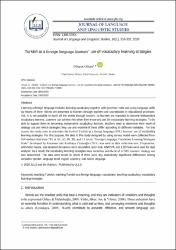| dc.contributor.author | Göçen, Gökçen | |
| dc.date.accessioned | 2021-05-05T14:10:23Z | |
| dc.date.available | 2021-05-05T14:10:23Z | |
| dc.date.issued | 2020 | en_US |
| dc.identifier.citation | GÖÇEN, Gökçen. "Turkish as a Foreign Language Learners’ Use of Vocabulary Learning Strategies". Journal of Language and Linguistic Studies, 16.1 (2020): 316-332. | en_US |
| dc.identifier.uri | https://dergipark.org.tr/tr/download/article-file/1032213 | |
| dc.identifier.uri | http://www.jlls.org/index.php/jlls/article/view/1612/557 | |
| dc.identifier.uri | https://hdl.handle.net/11352/3481 | |
| dc.description.abstract | Learning a foreign language includes learning vocabulary together with grammar rules and using language skills
by means of them. Words are presented to learners through teachers and coursebooks in educational processes.
Yet, it is not possible to teach all the words through lessons, so learners are expected to become independent
vocabulary learners. Learners can achieve this when they know and use the vocabulary learning strategies. To be
able to support them in becoming independent vocabulary learners, teachers need to determine their level of
strategy use and which strategies they use and examine if these differ according to different variables. For this
reason, this study aims to determine the level of Turkish as a foreign language (TFL) learners’ use of vocabulary
learning strategies. For this purpose, the data in this study designed by using survey model were collected from
169 students that learn TFL at A1, A2, B1, B2, and C1 levels. “Foreign Language Vocabulary Learning Strategies
Scale” developed by Kocaman and Kızılkaya Cumaoğlu (2014) was used as data collection tool. Frequencies,
arithmetic means, and standard deviations were calculated, and t-test, ANOVA, and LSD tests were used for data
analysis. As a result, the vocabulary learning strategies were identified and the level of TFL learners’ strategy use
was determined. The data were tested to check if there were any statistically significant differences among
variables: gender, language level, region, ancestry, and native language. | en_US |
| dc.language.iso | eng | en_US |
| dc.publisher | Hacettepe University | en_US |
| dc.relation.isversionof | 10.17263/jlls.712838 | en_US |
| dc.rights | info:eu-repo/semantics/openAccess | en_US |
| dc.subject | Teaching Turkish | en_US |
| dc.subject | Teaching Turkish as a Foreign Language | en_US |
| dc.subject | Vocabulary | en_US |
| dc.subject | Teaching Vocabulary | en_US |
| dc.subject | Vocabulary Learning Strategies | en_US |
| dc.title | Turkish as a Foreign Language Learners’ Use of Vocabulary Learning Strategies | en_US |
| dc.type | article | en_US |
| dc.relation.journal | Journal of Language and Linguistic Studies | en_US |
| dc.contributor.department | FSM Vakıf Üniversitesi, Eğitim Fakültesi, Türkçe ve Sosyal Bilimler Eğitimi Bölümü | en_US |
| dc.contributor.authorID | https://orcid.org/0000-0001-7552-8406 | en_US |
| dc.identifier.volume | 16 | en_US |
| dc.identifier.issue | 1 | en_US |
| dc.identifier.startpage | 316 | en_US |
| dc.identifier.endpage | 332 | en_US |
| dc.relation.publicationcategory | Makale - Uluslararası Hakemli Dergi - Kurum Öğretim Elemanı | en_US |
| dc.contributor.institutionauthor | Göçen, Gökçen | |



















